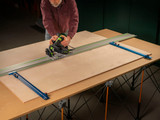Can You Use a Track Saw To Joint Boards?
Jointing boards is a crucial step in woodworking and generally involves flattening one face and one edge of your stock. From there, a planer and table saw can be used to square and parallel the opposite edges, resulting in parallel and square stock ready for fine woodworking.
While the jointer and planer have traditionally been the tools of choice for milling, many woodworkers wonder if a track saw can play a part in the process. We’ll explore the possibility of using a track saw to joint boards and discuss its advantages and limitations.
Advantages of Using a Track Saw for Jointing
- Portability: You can bring a track saw to the workpiece, making it ideal for on-site work or small workshops with limited space.
- Long, Straight Cuts: A track saw excels at making perfectly straight cuts when used with a guide rail. Guide rails are available in long lengths and can connect via Guide Rail Connectors, resulting in an effective jointing length surpassing the effective capacity of many long-bed (72”+) jointers.
- Versatility: Track saws can handle various cutting tasks beyond jointing, such as crosscuts and bevel cuts. This versatility makes them valuable additions to any woodworking toolkit.
Limitations of Using a Track Saw for Jointing
- Width Limitation: While a track saw can make straight cuts along the length of a board, it may not be ideal for jointing narrow boards. Once the board becomes narrower than the guide rail (usually less than 8” in width), ensure the guide rail remains perfectly flat on top of the board. Use scrap wood blocks matching the same thickness as the board you’re cutting to accomplish this.
- Edge Quality: Achieving the same level of edge quality as a dedicated jointer can be challenging with a track saw. Jointers have specialized cutter heads (e.g., helical shearing cutters) that provide a superior surface finish. However, if you’re finish-sanding every surface, this usually isn’t a big deal.
Tips for Using a Track Saw for Jointing
If you decide to use a track saw to joint boards, here are some tips to achieve the best results. Use a long, straight track saw guide rail to keep the saw on track and create a straight edge. Also, pay attention to setup and alignment in order to minimize errors in flatness or straightness. Finally, ensure the bevel setting of your track saw is set to 90 degrees. Check with a combination square or similar tool, with the track saw unplugged (or battery removed), placed upside down, and fully plunged.
While a track saw can be a portable and versatile tool for making straight cuts, it may not fully replace a jointer, especially for narrow stock and precise work. However, with the right techniques and attention to detail, you can use a track saw for jointing in certain situations, particularly when portability and space are priorities in your woodworking projects.
Recent Posts
-
What Size Guide Rail Do I Need? Choosing the Right Length (and When to Use Extensions)
The scenario: you need to make a cut in that full size plywood panel sitting in the corner of your s …6th Nov 2025 -
Best Track Saw Systems: Expert Review & Advice
The track saw market has changed considerably over the past three years. Back then, your options wer …6th Nov 2025 -
Systainer Storage Guide: Organize Your Workshop Tools
Picture this: you're setting up for what should be a straightforward series of cuts, but you can't l …2nd Sep 2025




